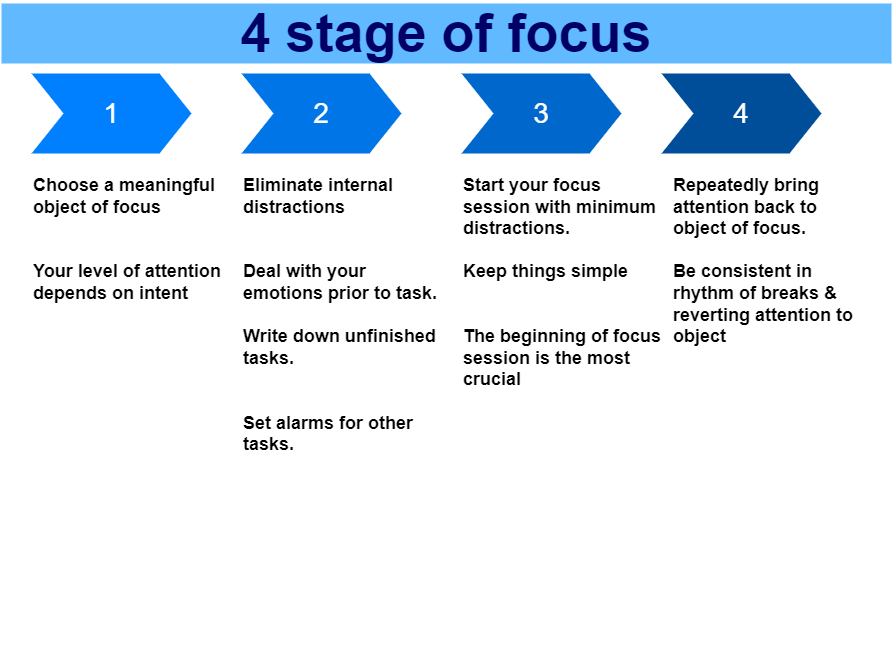Hyper Focus Summary
Hyper focus is intentionally filling up your entire attention space with one task, Chris Bailey shows us that focus is a process we apply to use our attention space, he goes on to show that we have a limit to our attentions span & growing your focus is merely growing your attention span.
Switch off autopilot:
Being on autopilot is doing things that you did not intend to do, amazingly most people live their life this way, hyper focus teaches us how to use distraction mode as a tool & grow our focus. Being distracted isn't a problem, but being distracted as the only mode our mind uses is not healthy for any functional person with goals.
It means being more intentional with how you act, react & plan for the events in your life.
Switching off autopilot means, taking a step-by-step process to replace the distracted-life habit with a focused-life habit, effectively taking control of what and who is filling your attentions space.
It also means putting a stop to multitasking. The reality is that you move things in an out of your attention span as you switch tasks & this in actual fact lowers your ability to focus longer.
Attention overload:
Your attention span has limits & an overload happens as you keep "switching tasks" or attempting to do attention demanding tasks at the same time.
Being a multitasker means you are busy but not effective or effective and not efficient, so stop lying to yourself.
Find the limits of your attention span by seeing how many tasks you can keep in mind without dropping the ball, this will help you and your job a lot.

Daily intension:
How you feel about a task & your intention around tasks impacts your focus time 'how long you focus on it without distracting yourself'. So you need a daily ritual to help you set your intension for the day.

1. Rule of three:
- Start the day with a decision on what three things you would must accomplish.
After making the list just put it in a place that will be accessible to you all day.
2. Most consequential tasks:
Review your task list & try to understand which of the tasks will create a domino effect, which task will impact the rest.
Find the task that makes the rest easy or will reduce the load for you in some way.
3. Hourly awareness chime:
Set hourly chime that will remind you to be aware what it is that your mind is spending attention on.
Regular checks of what the attention space is holding is important to help you realize what is important to you & how your time is wasted on distracted mode.
The four stages of hyper focus:
Entering autopilot mode is easier than getting into hyper focus, entering hyper focus needs your effort, the more meaningful that task you will focus on the easier it is to focus. Here are steps to make focus easy:
- 1. Choose a productive & meaningful object of attention.
- 2. Eliminate as many external & internal distractions as you can.
- 3. Focus on that chosen object of attention.
- 4. Continually draw your focus back to that one object of attention.
Growing your attention span:
One of the most important tasks to make your focus better is to grow your attention span. Your attention is the bouncer that protects what you focus on, or how much tasks you can focus on per unit of time. Hyper focus is hard when you still starting out so this process helps you get into it better:
Shrink your focus period until you don't feel resistance.
Know your focus time, the best focus time is the one where it effortless to work with.
Treat yourself like a person who does not have time for extra tasks, your time and attention are both a commodity so only attend tasks that are worth it.
Hyper focus as a habit not a once in a while or when it suites you, distracted mode has become the default for most of us the best way to change that is to swap it with hyperfocus as a habit.
Recharge your mind by using distraction mode, take the chance to have an empty attention space. rest isn't a luxury - its a necessity for productivity.
 NB: these tasks will be hard in the beginning but doing it for while is worth it.
NB: these tasks will be hard in the beginning but doing it for while is worth it.
Scatterfocus :
Distraction mode has beneficial value if applied by choice, yet with what the world & social media has become there are tools & processes created to keep people distracted for comercial reasons. Chris shows us 3 modes to use distraction mode productively.
Capture mode:
this is keeping the mind roaming freely & consuming life as it comes without holding anything specific in the attention space.
the point of this isn't to let things come and go into the mind but actively being conscious of what comes and goes but focusing on none of it specifically.
Problem crunching mode:
after finding yourself a problem you must solve, by distracting yourself from it with habitual tasks or something entertaining your mind will find creative ways to solve the task for your in th background.
This starts with you taking note of the problem and its dynamics. then keeping that in the back of the mind and move on with life and periodically coming back to it then distract yourself again. Some times going as far as sleeping on the problem brings you a solution.
Habitual mode:
Doing your habitual tasks can be soothing to the mind, giving it a rest from focus and allowing it to move randomly from task to task.
Habitual mode is a period where some of us will see events clearly / differently, with an unbiased state of mind.
